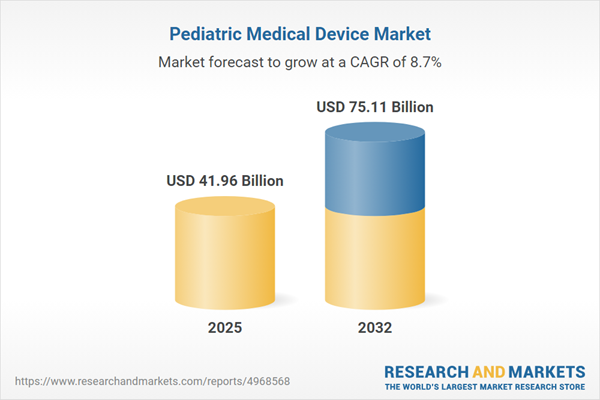Speak directly to the analyst to clarify any post sales queries you may have.
The pediatric medical device market faces a critical phase of transformation as industry leaders reassess strategies amid shifting clinical priorities and regulatory advancements. In this landscape, responsiveness to evolving care delivery models and digital health innovation is central to sustainable business operations and outcomes.
Market Snapshot: Pediatric Medical Device Market Overview
The global pediatric medical device market is projected to reach USD 41.96 billion by 2025, rising from USD 38.57 billion in 2024, and is forecasted to expand to USD 75.11 billion by 2032, reflecting a CAGR of 8.68%.
Growth is propelled by the increasing prevalence of chronic conditions in children and swift adoption of digital, minimally invasive technologies designed for pediatric care. Regulatory requirements are prompting a reevaluation of traditional operating models, challenging both established players and emerging firms. Companies navigating these changes benefit from early trend identification and the ability to differentiate offerings, particularly when adapting for various international markets.Pediatric Medical Device Market: Scope & Segmentation
A thorough understanding of pediatric medical device market segmentation empowers executives to forecast trends, enhance procurement effectiveness, and address compliance across multiple regions and clinical contexts. Diverse patient needs, emerging healthcare technologies, and evolving care settings influence these critical segments:
- Product Types: Diagnostic imaging equipment, including CT scanners, MRI, ultrasound, and X-ray devices, enhance early detection and monitoring. Infusion and medication delivery solutions are engineered for precise pediatric dosing. Monitoring systems track cardiac, respiratory, fetal, and general pediatric parameters. Respiratory support devices, such as CPAP and ventilators, address acute care challenges. Surgical instruments focus on minimizing risk and supporting positive outcomes for young patients.
- End Users: Hospitals, ambulatory surgical centers, and home care providers utilize a breadth of medical and digital devices to optimize outcomes, expand home-based care, and streamline processes in diverse pediatric settings.
- Age Groups: Devices are adapted for neonates, infants, children, and adolescents, supporting safe, developmentally appropriate care throughout all pediatric stages.
- Distribution Channels: Direct sales, distributor networks, and online platforms enable accessibility, regulatory compliance, and comprehensive after-sales service within distinct market environments.
- Geographies: The market covers North America, Europe, Middle East, Africa, and Asia-Pacific, influenced by regional adoption drivers and local regulatory frameworks. Major economies, such as the United States, China, India, Germany, and Brazil, exhibit unique growth characteristics and opportunities as care models evolve.
- Key Companies: Leading firms include Medtronic plc, Abbott Laboratories, Boston Scientific Corporation, Stryker Corporation, Becton, Dickinson and Company, Teleflex Incorporated, GE HealthCare Technologies Inc., Koninklijke Philips N.V., Siemens Healthineers AG, and Edwards Lifesciences Corporation, each providing extensive product portfolios and global support structures.
Key Takeaways for Senior Decision-Makers
- Promote collaboration between clinical, technology, and regulatory experts to address emerging standards and support market access strategies internationally.
- Integrate digital health and remote monitoring to facilitate effective care transitions and expand home-based pediatric services.
- Focus on embedding age-appropriate and developmentally relevant features in device design for optimized safety and clinical impact.
- Revise procurement and supply chain processes to manage differences in regulation, reimbursement, and operations across key geographies, building adaptability into business operations.
- Augment product offerings with portable and connected solutions that align with the growing need for care beyond traditional clinical settings.
Tariff Impact: Navigating New Cost Structures
Upcoming tariff changes in the United States are set to shift device cost structures and sourcing dynamics from 2025. As a response, manufacturers are expanding supply chains in Europe and Asia-Pacific to maintain stability and ensure reliable delivery under shifting economic conditions. The growing adoption of reusable devices, shared procurement models, and streamlined purchasing supports operational continuity and helps manage financial risk during periods of uncertainty.
Methodology & Data Sources
This research draws from direct interviews with senior executives, clinical leaders, and procurement professionals. Peer-reviewed publications and regulatory intelligence platforms further validate findings, providing actionable insights for pediatric medical device stakeholders.
Why This Report Matters
- Offers segmented market analysis and regional perspectives, aiding alignment with ongoing shifts in pediatric care delivery and regulatory demands.
- Supports leadership in deploying data-driven approaches for procurement, risk strategies, and technology adoption.
- Enhances strategic planning and readiness for executives addressing current and future sector challenges.
Conclusion
Senior decision-makers will find actionable guidance here to advance risk management, sustain operational agility, and drive ongoing growth as pediatric medical technology and care standards evolve.
Additional Product Information:
- Purchase of this report includes 1 year online access with quarterly updates.
- This report can be updated on request. Please contact our Customer Experience team using the Ask a Question widget on our website.
Table of Contents
3. Executive Summary
4. Market Overview
7. Cumulative Impact of Artificial Intelligence 2025
Companies Mentioned
The companies profiled in this Pediatric Medical Device market report include:- Medtronic plc
- Abbott Laboratories
- Boston Scientific Corporation
- Stryker Corporation
- Becton, Dickinson and Company
- Teleflex Incorporated
- GE HealthCare Technologies Inc.
- Koninklijke Philips N.V.
- Siemens Healthineers AG
- Edwards Lifesciences Corporation
Table Information
| Report Attribute | Details |
|---|---|
| No. of Pages | 186 |
| Published | October 2025 |
| Forecast Period | 2025 - 2032 |
| Estimated Market Value ( USD | $ 41.96 Billion |
| Forecasted Market Value ( USD | $ 75.11 Billion |
| Compound Annual Growth Rate | 8.6% |
| Regions Covered | Global |
| No. of Companies Mentioned | 11 |









